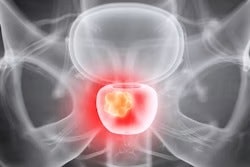While recent evidence suggests that theranostic agents may be more effective when used earlier for prostate cancer patients, experts recommend proceeding conservatively with theranostic treatments until more is known about dose limits, according to an article published March 21 by the RSNA.
Data from theranostics is starting to focus on radiation dosimetry and dose limits in relation to kidney and other organ damage, said Nadine Mallak, MD, associate professor of body imaging and nuclear medicine at Oregon Health and Science University in Portland.
The article points out that compared with external beam radiation therapy (EBRT), the radiation dose for theranostics is lower but is delivered over a longer period. This allows for tissue and DNA repair, which means that normal organs will tolerate higher doses than they would with EBRT. Mallak noted that the dose limit for kidneys with EBRT is 23 Gray (Gy), and doses higher than that will harm the organ. With theranostics, there is evidence that radiation doses to the kidney can go up to more than 30 Gy, according to Mallak.
“This means we can achieve higher activities of the therapeutic agent before reaching the toxicity to the kidneys,” Mallak said in the article. “So, we know we can go with higher doses with theranostics, but the dose limits to normal organs need to be established.”
The article notes that dosimetry is more complex in planning radionuclide therapies, due to factors such as patient-specific variation in the distribution of tumors, variable biodistribution and kinetics of the radiopharmaceutical, and challenges in consistent quantification of radiation from SPECT systems. Consequently, theranostics is being performed conservatively until more is known about the dose limits, according to the report.
“These agents work really well and they’re already helping a lot of patients,” Mallak said in the article. “Once we have more dosimetry data, we can take it even further to personalize treatment for our patients.”




















